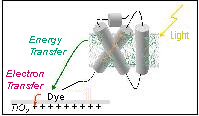
Light-harvesting complexes in plants collect sunlight energy very efficiently and conduct it to the reaction centers with almost 100 % quantum efficiency. Moreover, they are self-organizing and, in comparison with other components of the photosynthetic apparatus, quite stable. Therefore, it seems worthwhile to test them in technical applications such as photovoltaic solar cells.
In this context, too, it is very helpful to be able to produce structurally modified recombinant versions of LHCII. This way, reactive anchor groups can be introduced into the protein that then allow to attach it chemically to other components or to immobilize it on solid surfaces. By coupling LHCII with an acceptor dye we have constructed a minimal model of a photosystem, and by attaching rhodamine dyes to LHCII we have been able to partially fill the green gap in the LHCII absorption spectrum. Hybrid constructs have been made not only with organic dyes but also with inorganic semiconductor nanocrystals (quantum dots) or both in order to study the biochemical and optical properties of such constructs (collaboration with Prof. Thomas Basché, Physical Chemistry, Johannes-Gutenberg-Universität Mainz, Prof. Klaus Müllen, MPI for Polymer Research, Mainz; Ref.: Wolf-Klein et al., 2002; Liu et al., 2008; Gundlach et al., 2009; Peneva et al. 2010, Lauterbach et al., 2010, Kibrom et al., 2011, Werwie et al., 2012, Werwie et al. 2014, Werwie et al. 2018).